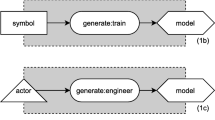Abstract
A framework of fully integrated hybrid systems (HSs) is proposed for the development and management of HS which involve databases, advanced user interfaces, symbolic systems, and artificial neural networks. This framework provides a common input–output interface among those HS modules developed on the framework, with a completely two-directional flow control and a highly parallel processing. This integration framework facilitates the incorporation of heterogeneous modules, together with their subsequent management and updating.







Similar content being viewed by others
References
McGarry K, Wermter S, MacIntyre J (1999) Hybrid neural systems: from simple coupling to fully integrated neural networks. Neural Comput Surv 2:62–94
Wermter S, Sun R (2000) Hybrid neural systems. Springer, New York
Sun R (2002) Hybrid systems and connectionist implementationalism. In: Encyclopedia of cognitive science. Nature Publishing Group (MacMillan), London, pp 697–703
Sun R (1994) Integrating rules and connectionism for robust commonsense reasoning. Wiley, New York
Corchado E, Corchado JM, Abraham A (2007) Innovations in hybrid intelligent systems. Springer, Heidelberg
Christos C, Giua A, Seatzu C, Zaytoon J (2006) Analysis and design of hybrid systems. Elsevier, Alghero
Al-Zobaidie A, Grimson JB (1987) Expert systems and database systems: how can they serve each other? Expert Syst 4:30–37
Codd EF (1972) Derivability, redundancy and consistency of relations in large data banks. IBM research report RJ 599
Codd EF (1982) Relational database: a practical foundation for productivity. Commun ACM 25:109–117
Santos A (1998) Methodology for hybrid systems including expert systems, artificial neural networks and databases. Ph.D. thesis. University of A Coruña, A Coruña
Santos A, Arcay B, Dorado J, Pazos A (2002) Artificial neural networks manipulation server. Research on the integration of data bases and artificial neural networks. Neural Comput & Appl 11:3–16
Weiss SM, Kulikowski CA (1991) How to estimate the true performance of a learning system. In: Weiss SM, Kulikowski CA (eds) Computer systems that learn. Morgan Kaufmann, San Francisco, pp 17–49
Walker LJ, Johnston J (1999) Guidelines for the assessment of indirect and cumulative impacts as well as impact interactions. Office for official publications of the European Communities, Luxembourg
Goldberg DE (1989) Genetic algorithms in search, optimization and machine learning. Wesley, Massachusets
Holland JH (1975) Adaptation in natural and artificial systems. University of Michigan Press, Michigan
Holland JH (1996) Complex adaptive systems. In: Pazos A (ed) Artificial neural networks and adaptive systems. University of A Coruña Press, A Coruña, pp 259–295
Fogel LJ, Owens AJ, Walsh MJ (1966) Artificial intelligence through simulated evolution. Wiley, New York
Fogel DB (1995) Evolutionary computation: toward a new philosophy of machine intelligence. IEEE Press, New Jersey
Dasgupta D (1999) Artificial immune systems and their applications. Springer, Berlin
Feldman JA, Ballard DH (1982) Connectionist models and their properties. Cogn Sci 6(1):205–254
Tickle A, Maire F, Bologna G, Andrews R, Diederich J (2000) Lessons from past, current issues and future research directions in extracting the knowledge embedded in artificial neural networks. In: Wermter S, Sun R (eds) Hybrid neural systems. Springer, Heidelberg, pp 230–245
Teodorescu H (2000) Intelligent systems and interfaces. Kluwer, Boston
Author information
Authors and Affiliations
Corresponding author
Rights and permissions
About this article
Cite this article
Santos, A., Romero, J.J., Carballal, A. et al. Framework of fully integrated hybrid systems. Neural Comput & Applic 21, 45–53 (2012). https://doi.org/10.1007/s00521-011-0672-9
Received:
Accepted:
Published:
Issue Date:
DOI: https://doi.org/10.1007/s00521-011-0672-9




